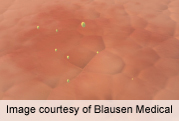
THURSDAY, Aug. 30 (HealthDay News) — Bacteria carried by tiny mites on the skin might be responsible for the common dermatological condition known as rosacea, researchers say.
If this theory does prove to be true, then new and better treatments for rosacea may be on the way, according to a review published online Aug. 30 in the Journal of Medical Microbiology.
One expert unconnected to the study said the findings are encouraging.
“[If] these mites exacerbate or harbor bacteria, that could change the therapies that are used to treat rosacea,” reasoned Dr. Michele Green, a dermatologist with Lenox Hill Hospital, in New York City. “This could revolutionize treatment.”
Green noted that some pharmaceutical companies are already exploring treatments that could combat rosacea from this vantage point.
Rosacea affects some 3 percent of the population, mostly adults between the ages of 30 and 50 and more women than men.
No one is sure exactly what causes the condition but it manifests as reddening and inflammation of the skin around the cheeks, nose and chin.
Although rosacea is often successfully treated with antibiotics, no one has yet proven that the condition is caused by bacteria.
Experts believe that immune dysfunction, vascular problems and/or environmental factors, including nutrition, could contribute to the condition.
This review article, led by Dr. Kevin Kavanagh of the National University of Ireland, outlined evidence supporting the idea that bacteria living in the Demodex folliculorum mite, which is present on the skin of between 20 percent to 80 percent of healthy humans, may be responsible for rosacea. The mite is typically harmless and lives around the facial hair follicles.
However, the authors say research has shown that there are more Demodex mites residing on the skin of rosacea patients than in people without the condition.
The bacterium known as Bacillus oleronius has also been found in the digestive tract of a Demodex mite taken from a person with rosacea. This bacterium is susceptible to some of the antibiotics used to treat rosacea, and it also produces molecules that trigger an immune reaction in people with rosacea.
Another type of bacteria, Staphylococcus epidermidis, has been found in pustules of rosacea patients but not in areas of the skin that are rosacea-free. This bacterium, as well, is sensitive to many of the antibiotics used to treat rosacea.
“This research is provocative in that it is proposing a cause for rosacea which up to this point has been unknown,” said Dr. Chris Adigun, an instructor in the department of dermatology at NYU Langone Medical Center, in New York City.
But Adigun adds, it will be difficult to prove that bacteria within Demodex mites are responsible for rosacea.
“We find it on healthy people as well as on people with rosacea,” she pointed out. “Furthermore, treatment options that improve rosacea symptoms do not alter the concentration or life cycle of mites,” she added.
More information
The American Academy of Dermatology has more on rosacea.

